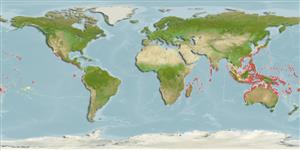Actinopterygii (ray-finned fishes) >
Perciformes (Perch-likes) >
Gobiidae (Gobies) > Gobiinae
Etymology: Bathygobius: Greek, bathys = deep + Latin, gobius = gudgeon (Ref. 45335).
Environment / Climate / Range
Ecology
Marine; reef-associated. Tropical, preferred ?
Indo-West Pacific and Southeast Atlantic.
Size / Weight / Age
Maturity: Lm ? range ? - ? cm
Max length : 5.0 cm TL male/unsexed; (Ref. 2798)
Dorsal
spines
(total): 7;
Dorsal
soft rays
(total): 9;
Anal
spines: 1;
Anal
soft rays: 8. Males uniformly dark brown; fins dusky to black (Ref. 2798). Females light brown with crossbars on body; caudal base with dark bar; dorsal and caudal fins mottled, other fins clear (Ref. 2798); characterized further by having upper 5-6 pectoral rays partly free of membrane; rounded caudal fin; longitudinal scale series 28-32; predorsal scales 9-13, not reaching rear margin of preopercle; cheek, opercle, pectoral fin base and prepelvic area without scales; ctenoid body scales, becoming cycloid on head and anterior body (short distance anterior to first dorsal fin); depressed head, width greater than depth; depth of body 4.6-5.9 in SL (Ref. 90102).
Inhabits rock pools of intertidal zone, rocky shores and mangrove habitat (Ref. 90102).
Life cycle and mating behavior
Maturity | Reproduction | Spawning | Eggs | Fecundity | Larvae
Hoese, D.F., 1986. Gobiidae. p. 774-807. In M.M. Smith and P.C. Heemstra (eds.) Smiths' sea fishes. Springer-Verlag, Berlin. (Ref. 2798)
IUCN Red List Status (Ref. 115185)
CITES (Ref. 94142)
Not Evaluated
Threat to humans
Harmless
Human uses
More information
Common namesSynonymsMetabolismPredatorsEcotoxicologyReproductionMaturitySpawningFecundityEggsEgg development
ReferencesAquacultureAquaculture profileStrainsGeneticsAllele frequenciesHeritabilityDiseasesProcessingMass conversion
Tools
Special reports
Download XML
Internet sources
